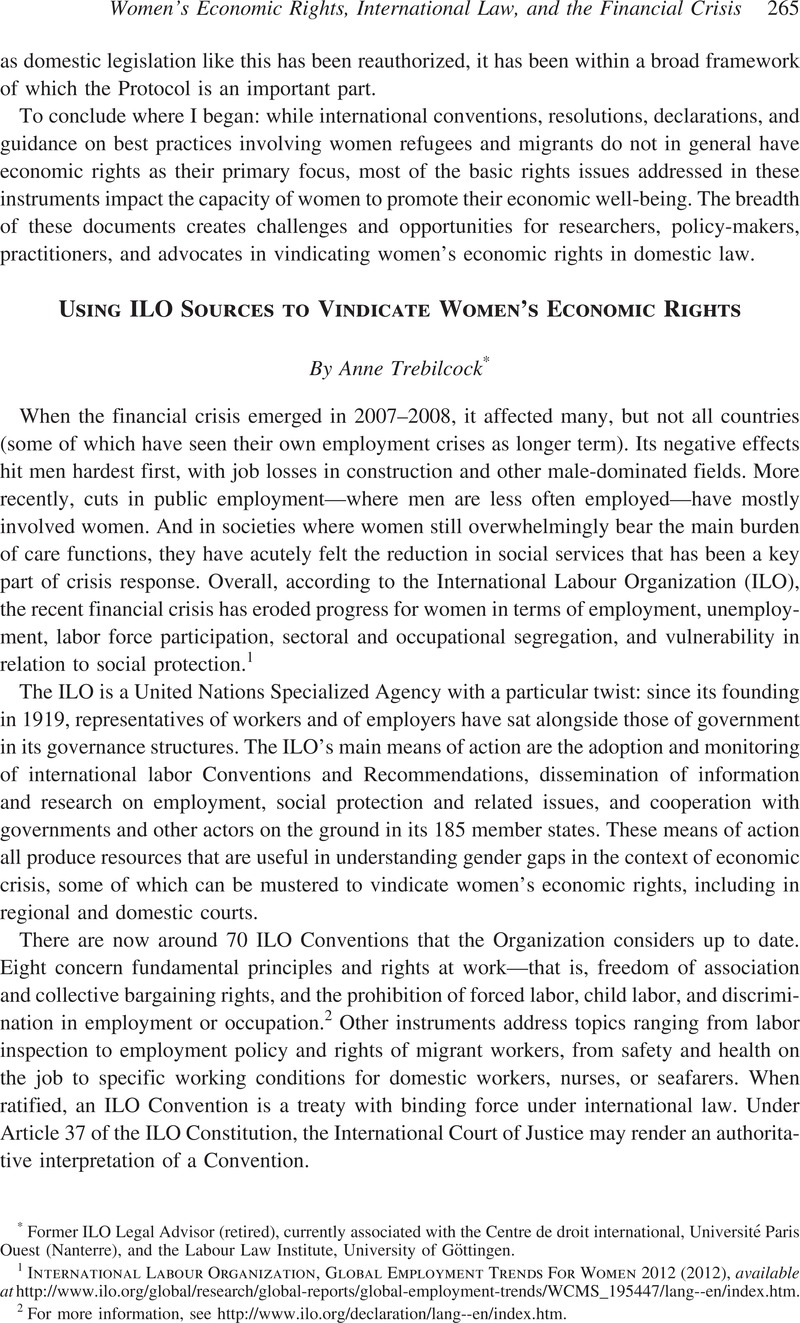No CrossRef data available.
Published online by Cambridge University Press: 20 January 2017

1 International Labour Organization, Global Employment Trends For Women 2012 (2012), available at http://www.ilo.org/global/research/global-reports/global-employment-trends/WCMS_195447/lang--en/index.htm.
2 For more information, see http://www.ilo.org/declaration/lang--en/index.htm.
3 See ILO, Rules of the Game:A Brief Introduction to International Labour Standards (rev. ed. 2009).
4 International Labour Conference, 101st Session (May 30–June 14, 2012), Report of the Committee of Experts on the Applications of Conventions and Recommendations, Report III (Part 1A) 512–17.
5 Id. at 159–64.
6 International Labour Conference, 102nd Session (June 5–20, 2013), Report of the Committee on the Application of Standards, 16 Record of Proceedings Part II, 81 (2013).
7 Id.
8 Deakin, Simon, From Constraining to Rebalancing: The Role of Transnational Social Rights in Shaping European Union Economic Policy, in Internationale Arbeitsrecht 353 (Däubler, W. & Zimmer, R. eds., 2013)Google Scholar.
9 See, e.g., Bellace, Janice, The ILO and the Right to Strike, 153 Int’l Labour Rev. 29 (2014)CrossRefGoogle Scholar.
10 Fredman, Sandra, Engendering Socio-economic Rights, in Women’s Human Rights 217, 240 (Hellum, Anne & Aasen, Henriette Sinding eds., 2013)CrossRefGoogle Scholar.
11 Vosko, Leah F., Gender, Precarious Work, and the International Labour Code: The Ghost in the ILO Closet, in Precarious Work; Women and the New Economy: The Challenge to Legal Norms 53 (Fudge, Judy & Owens, Rosemary eds., 2006)Google Scholar.
12 Owens, Rosemary, Women, ‘Atypical’ Work Relationships and the Law, 19 Melb. U. L. Rev. 399–430 (1993)Google Scholar; Tzehaines Teklè, Labour Law and Worker Protection in Developing Countries 36–47 (2010).
13 Blackett, Adelle & Sheppard, Coleen, The Links Between Collective Bargaining and Equality 9 (ILO Declaration, Working Paper No. 10, 2003)Google Scholar.
14 Fudge, Judy, Gender, Equality and Capabilities: Care Work and Sustainable Development, in The Role of Labour Standards in Development: From Theory to Sustainable Practice? 41, 49 (Novitz, Tonia & Mangan, David eds., 2011)Google Scholar.
15 Blackett, Adelle, The Decent Work for Domestic Workers Convention and Recommendation, 2011, 106 AJIL 778 (2012)Google Scholar.
16 ILO, Global Employment Trends Report 2014 (2014).
17 International Labour Conference, 98th Session (June 3–19, 2009), Gender Equality at the Heart of Decent Work, Report VI (2009).
18 Martin Oelz, Shauna Olney & Manuela Tomei, Equal Pay: An Introductory Guide (2013).
19 International Labour Law and Domestic Law (Xavier Beaudonnet ed., 2010).
20 Compendium of Court Decisions, http://compendium.itcilo.org (last visited Apr. 12, 2014).
21 See Contrôle et mise en oeuvre par les juridictions et administrations de droit interne, in 1 Droit International Social 517 (Thouvenin, Jean-Marc & Trebilcock, Anne eds., 2013)Google Scholar.
22 Demir & Baykara v. Turkey, [2008] ECHR 1345. See also Ebert, Franz & Oelz, Martin, Bridging the Gap Between Labour Rights and Human Rights: The Role of ILO Law in Regional Human Rights Courts (International Institute for Labour Studies, Discussion Paper No. 212/2012, 2012)Google Scholar, available at http://www.ilo.org/wcmsp5/groups/public/---dgreports/---inst/documents/publication/wcms_192786.pdf.